Abstract
Policies directly affect land-use change, which in turn, affects ecosystem services. In parallel with the implementation of a full-scale development program for the western region, the Chinese government has introduced a series of ecological protection and restoration strategies for development and construction. This study conducted a quantitative spatial evaluation of the ecosystem service value (ESV) of national nature reserves in the western region under this dual policy of development and protection. On the basis of land-use data and related evaluation parameters, fluctuations in the valuation of ecosystem services during 2000–2010 were analyzed in response to land-use changes under the comprehensive policy. Results showed that the increases in the areas of forestland and water bodies led to an increase of CNY 74.1 billion in the ESV from 2000 to 2010, equivalent to 2.02%. Grassland with increased production capacity and water bodies were the main factors driving the total ESV dynamics. Values of all ES increased significantly. Therefore, the ecological conservation and restoration policy, along with the development policy, had a positive influence on ecosystem services in the nature reserves in western China.
1. Introduction
For a long time, the human impact on ecosystems has been mostly negative, owing to an insufficient understanding of ecosystem services. The overexploitation of natural resources by humans and the substantial discharge of pollutants into the environment has led to continuous damage to, and weakening of, ecosystem services [1]. For one thing, the negative impact of human activities, such as urbanization construction, deforestation, and damaging forests to reclaim land, directly caused changes in land use, which in turn, directly weakened the ecosystem service [2,3]. Furthermore, human activities, such as long-term greenhouse gas emissions resulting in climate change, changing temperatures, and precipitation, have also directly affected ecosystem structure and functions [4]. According to the Fifth Assessment Report of the Intergovernmental Panel on Climate Change (AR5), it is likely (probability above 95%) that human activities have caused most of the global average surface temperature increase since the 1950s [5]. The trend of global warming has led to a continuous increase in high temperatures and changes in precipitation. According to the World Meteorological Organization, in 2018, extreme weather events such as high temperatures and drought occurred in many areas across the globe; for example, the temperature in the Arctic Circle reaching 32 °C, far higher than the average temperature of 10 °C in the same period of the previous year [6]. Drought and high temperatures have intensified wildfires in the northern hemisphere, and the extreme weather has had significant negative impacts on human health, agriculture, and ecosystems [6]. Climate change can, thus, affect ecosystem structure, composition, and function, and ultimately ecosystem service functions such as food production, water supply, flood regulation and storage, soil and water conservation, and biodiversity conservation [7,8,9,10,11].
National policies influence and determine the impact of human activities on the ecological environment. Since the 1950s, developed countries in Europe and North America have implemented policies of returning farmland to forest, such as the Roosevelt Engineering, Land Retirement, or Acreage Division and Conservation Reserve programs in the USA, and the policy of returning farmland to forest combined with reducing income in Britain [12,13,14]. These policy measures have transformed hundreds of thousands of hectares of arable land into parks, forests, and pastures [15,16], providing a reference for other countries to implement policies of returning farmland to forest. Additionally, some countries have begun to build large-scale green corridors, trans-boundary protected areas, or ecological networks between original protected areas to enhance biodiversity conservation. The most influential examples include the European Ecological Network and the Edmonton Ecological Network in Canada. The European Ecological Network also includes Natural 2000, the Emerald Network, the European Green Belt, the Pan-European Ecological Network, and other conservation planning projects, which have significantly improved the effectiveness of ecological protection in those countries [17,18,19,20].
China is the largest developing country in the world and economic development has long been the focus of its national policy. Over the past 40 years of reform and opening up, the proportion of China’s total economic output to the world economy has increased from 1.8% in 1978 to approximately 15% in 2017, making China the world’s second largest economy [21]. China’s GDP growth rate (9.5%) was also significantly higher than the global average annual growth rate (2.9%) over the same period [18]. However, owing to the inherent vulnerability of China’s ecological environment, social and economic pressures in the development process, and insufficient awareness of ecological and resource conservation, China’s economic development came at the expense of abnormal consumption of resources and severe ecology deterioration [22,23]. During the rapid economic development, tremendous changes also occurred in the ecological environment. As a result of its increasing awareness of ecological protection, the Chinese government has begun to carry out various activities, such as ecological protection and restoration projects and ecosystem management, to protect natural resources and enhance ecosystem service functions [24,25,26,27,28].
Nonetheless, the ecosystems in western China are still relatively fragile, with poor natural conditions and low economic development. Owing to the fragile ecological environment, landlocked geographic location, as well as the non-preferential development policies of the central government in the past and the unplanned land-use practices of the local people, western China is currently underdeveloped and lags behind other regions of the country [29]. To promote the coordinated development of the regional economy and improve the ecological environment, the Chinese government implemented a strategy for developing the western region in 2000, covering 12 provinces, and also implemented a strategy to strengthen the protection and construction of the ecological environment at the same time, in terms of development and construction [30]. Driven by this national policy, projects such as the Natural Forest Protection Project, Grain for Green Program, Beijing–Tianjin Sand Source Control Project, and Returning Grazing Land to Grassland Project were implemented in the western region to improve the quality of the ecological environment by actively increasing and restoring forestland and grassland and reducing soil erosion and sandstorm hazards [31].
The first stage of the full-scale development policy targeting the western region has been completed (2000–2010), and the second stage is now being implemented (2010–2020). Under the comprehensive policies of full-scale western development and ecological protection construction, remarkable results in infrastructure and ecological construction were achieved in the region. Currently, the evaluation of policy effectiveness mainly focuses on economic growth, infrastructure construction, public health, and basic educations [32,33], while that of ecological protection construction is focused on the new forest and grassland area, soil erosion control area, the single ecological function of water conservation, nature conservation construction, and the ecosystem services of certain projects [34,35,36,37,38]. However, the changes in the overall ecosystem service status under the comprehensive policy are rarely studied.
To identify the ecosystem services changes in the western region during the first implementation stage of the full-scale development policy driven by the comprehensive policy of development and protection, the national nature reserves in the western development region were taken as a study area to evaluate ecosystem service value (ESV) and the changes during 2000–2010 based on remote sensing, meteorological, statistical, and other relevant data. The main objectives were as follows: (1) quantify land-use changes after the first implementation stage of the comprehensive development and protection policy in the western region, (2) determine the ESV changes during the analyzed period, and (3) discuss the ESV dynamics driven by the national policy.
2. Materials and Methods
2.1. Study Area
The study area (80°25′–123°11′ E, 21°14′–52°8′ N) was located in western China, including 144 national nature reserves in Shaanxi Province, Gansu Province, Ningxia Hui Autonomous Region, Xinjiang Uygur Autonomous Region, Inner Mongolia Autonomous Region, Sichuan Province, Chongqing Municipality, Guizhou Province, Yunnan Province, Guangxi Zhuang Autonomous Region, Qinghai Province, and Tibet Autonomous Region. The total area was 875,498.35 km2, accounting for 13.01% of the total area of western China (Figure 1).
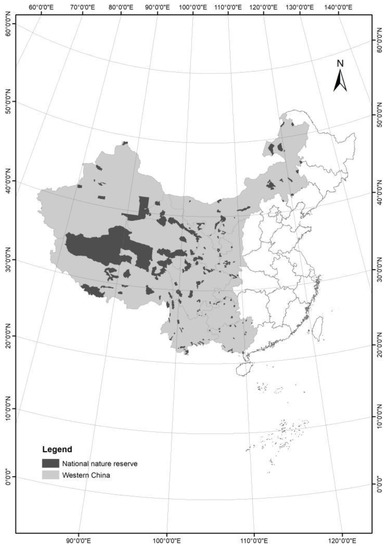
Figure 1.
Location of the study area in China.
The region is vast in area, with a substantial span of latitude and longitude, and complex and diverse terrains and landforms. The natural conditions are harsh and varied and the topographic features are complex, with a high proportion of mountains and a fragile ecological environment. Land desertification is a serious issue in the study area. Natural resources, especially biodiversity resources, are abundant. The region is the source of several major rivers, such as the Yangtze River, Yellow River, and Lancang River. There are significant differences in the climatic conditions of the region. The northwest is dry with little rainfall, the southwest is warm and humid, and the Qinghai–Tibet Plateau is cold, while temperature varies greatly overall. The local ecological environment is relatively fragile and rather poor. Important ecologically fragile areas include the Loess Plateau with serious soil erosion and the Yunnan–Guizhou Plateau, which is one of the world’s largest karst areas, with severe soil erosion.
2.2. Data Sources and Processing
The dataset of land use was extracted using ENVI 4.8 (Esri; Beijing, China) from Landsat Thematic Mapper imagery for 2000 and 2005 and from environmental satellite data for 2010 [39]. After completing the pretreatments, including band compositions, image fusion, image enhancement, and a unifying coordinate system, the maximum likelihood classifier of the supervised classification method was used to classify land use. The qualitative precision errors for deciphering the image in different years were controlled at the 90% level. The interpreted results were then compared with those of typical points from field survey results and early land-use data. The overall interpretation accuracies of the images from different years were over 90%. The total kappa coefficients were also above the minimum acceptable (0.7). ArcGIS 10.2 (Esri; Beijing, China) was used to process and analyze the land-use data with a background of raster images. According to the main geographical features of the study area, the region was divided into 28 land-use types, which were then classified under the seven primary land-use types listed in the resource and environmental database established by the Chinese Academy of Sciences (Table 1). The normalized difference vegetation index (NDVI) and meteorological data were obtained from the Goddard Space Flight Center (NASA) and National Meteorological Information Center [40,41], respectively. The dataset on vegetation was obtained from the GLC2000 database [42]. Data for the agricultural ecosystem net income from grain output per unit area were obtained from statistical data [43,44].

Table 1.
Land-use types in the national nature reserves of western China.
2.3. Methods
2.3.1. Land-Use Changes
Land-use changes are crucial for ESV dynamics. The rate of land-use change was calculated as:
where Ri and Rs represent the range of land-use change and dynamic rate of land-use change (%), Ua and Ub represent the initial and final areas of a given land use (km2), and T stands for the analyzed years, respectively.
Ri = (Ub − Ua)/Ua × 100%
Rs = (Ub − Ua)/Ua × 1/T × 100%
2.3.2. Standard Equivalent
The standard equivalent refers to the economic value of the annual natural grain yield of farmland with per unit national average yield. The equivalent factor of other ecosystem services can be determined based on this equivalent combined with expert knowledge. It can characterize and quantify the potential contribution of different types of ecosystems to ecosystem services [45].
where W represents the ESV of one standard equivalent (CNY·km−2); and Sr, Sw, Sc represent the percentage of the sown area of rice, wheat, and maize in the total sown area of the three crops in 2010 (%); and Fr, Fw, Fc represent the national average net profit per unit area of rice, wheat, and maize in 2010 (CNY·km−2), respectively.
W = Sr × Fr + Sw × Fw + Sc × Fc
2.3.3. Equivalent Value Factors
On the basis of Costanza and Folke’s [46] theory and investigation by 500 Chinese ecologists [45], the equivalent value factors method was widely used to assess the ecosystem services [47,48,49]. However, the research of Costanza et al. focuses on the global scale and lacks pertinence for China, while the latter is greatly influenced by subjective opinions, and needs to be adjusted according to the conditions of China’s ecosystems [45]. Some improvements were made to make unit ecosystem services value evaluation more practicable in China [39]. For instance, considering that ecosystem services generally have a positive correlation with biomass [45], it is feasible to overcome the spatial heterogeneity of the ecosystem services of a local area using a revision coefficient of net primary productivity (NPP) closely related to ecosystem services [18,45]. The corresponding equation of the equivalent value per unit area (Ei) is:
where Ei is the equivalent value per unit area in the study areas in year i, ni and Ni are the average net primary productivity (NPP) values of the ecosystems in the study areas and the country in year i, and E0 is the national average of equivalent value per unit area (Table 2), respectively. The Carnegie-Ames-Stanford approach (CASA) was used to evaluate the NPP value [50,51].

Table 2.
Equivalent value per unit area of ecosystem services in China [45].
Because species resources in nature reserves are more abundant than in general areas, another revision coefficient was necessary to calculate the equivalent value of biodiversity conservation. The density of important species was adopted as the parameter for correction. A database of 3337 rare and endangered species in China was determined from the International Union for Conservation of Nature (IUCN) endangered species level 3.1, the Convention on International Trade in Endangered Species appendix, the IUCN Red List of Threatened Species, a list of China’s endemic species, and lists of national key protected wildlife species. According to the information on species protection in 861 nature reserves in China, the distributions of 2157 rare and endangered species were established for the nature reserves. Given that protection in national nature reserves accounted for 96.2% of the objects and 99.7% of the area, the calculated value per unit area represented the important species well [18]. The equivalent value per unit area of biodiversity protection in nature reserves (Eb) was determined by Wang et al. [18] as:
where Eb stands for the equivalent value per unit area of biodiversity protection in nature reserves, d and D stand for the density of important species in nature reserves and on a national scale (species·km−1), and Eb0 is the national average equivalent value per unit area of biodiversity conservation in China, respectively.
2.3.4. ESV Evaluation
The ESV is mainly determined by land use and the equivalent value per unit area as [18]:
where ESVf, ESVk, and ESV are the ESVs of service function f, land-use type k, and ecosystem in year i (CNY·km−1), respectively; Uk is the area of land-use type k (km−2); and Eikf is the value coefficient for land-use type k with ES function type f (CNY·km−2), where the value of ecosystem services for a standard equivalent value per unit area is determined by the agricultural ecosystem net income from grain output per unit area (CNY·km−2) [43,44,52].
To assess the effect of ESV variation on land-use change, the contribution rate (Ckt) was estimated by Costanza et al. [38] as:
where Ckt refers to the percentage of the absolute value of ESV variation of land-use type k in the period h to the total amount of ESV variation of land-use type k in the period h (%), and ΔESVkh refers to the ESV change of land-use type k in period h (CNY), respectively.
3. Results
3.1. Land-Use Dynamics
Since the implementation of the full-scale development policy targeting the western region, grassland has dominated the land use in the national nature reserves in western China, accounting for more than 3/5 of the total area, followed by unused land and forest land, accounting for more than 1/6 of the total area (Figure 2, Figure 3 and Figure 4 and Table 3).
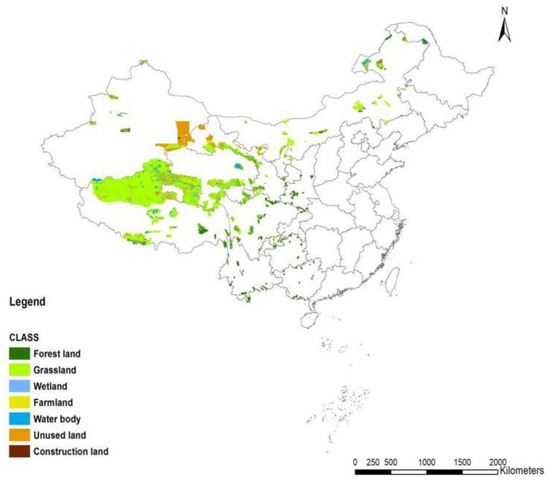
Figure 2.
Land use in the national nature reserves of western China in 2000.
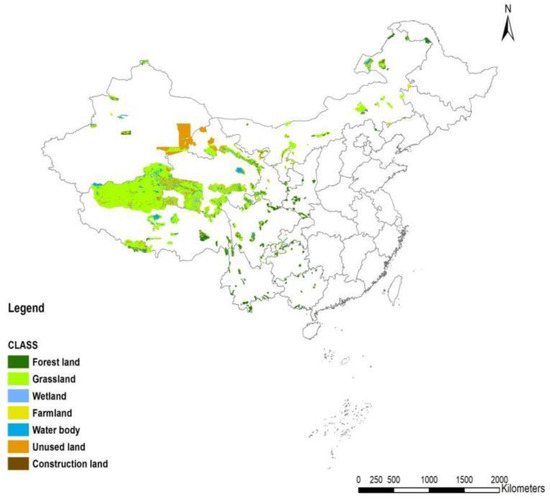
Figure 3.
Land use in the national nature reserves of western China in 2005.
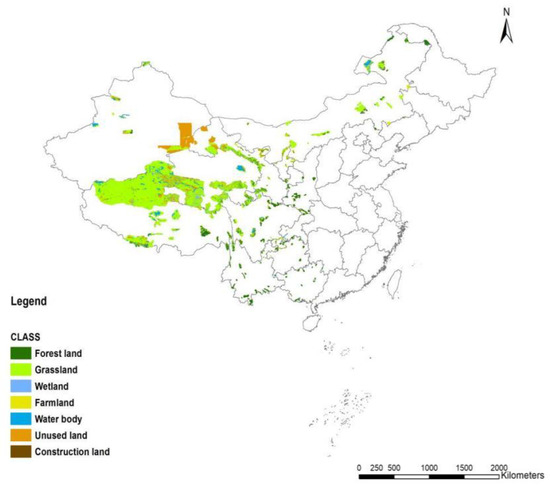
Figure 4.
Land use in the national nature reserves of western China in 2010.

Table 3.
Land-use dynamics in the national nature reserves of western China.
The most noticeable characteristics of land-use change in the nature reserves of western China in the whole study phase (2000–2010) were increases in water bodies and decreases in grassland. Especially in period I (2000–2005), the area of grassland declined by 1160.16 km2, while the area of water bodies increased by 1474.98 km2 (2.87%). In period II (2005–2010), other area changes were relatively stable except for construction land, which increased by 23.41%. The areas of forestland, water bodies, and construction land showed an increasing trend in both periods, while the areas of grassland, farmland, and unused land showed a continuously decreasing trend (Figure 5).
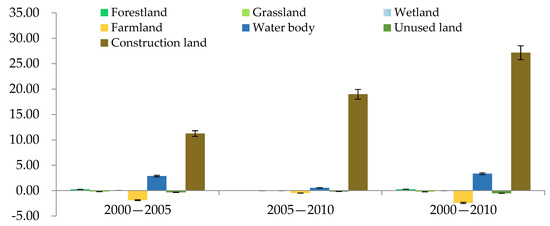
Figure 5.
Dynamic rates of land-use types.
In 2000–2005, the areas of forestland, wetland, water bodies, and construction land increased by 0.25%, 0.03%, 2.79%, and 10.10%, respectively, while the areas of grassland, farmland, and unused land decreased by 0.21%, 1.92%, and 0.34%, respectively. In 2005–2010, the areas of forestland, water body, and construction land increased by 0.02%, 0.55%, and 18.97%, respectively, while the areas of grassland, wetland, farmland, and unused land decreased by 0.03%, 0.03%, 0.48%, and 0.17%, respectively. Furthermore, over the period of 2000–2010, the areas of forestland, water body, and construction land continued to increase by 0.27%, 3.33%, and 27.15%, respectively, while the areas of grassland, farmland, and unused land continued to decrease by 0.24%, 2.42%, and 0.51%, respectively.
3.2. ESV Dynamics
The results suggest that the total ESVs of the national nature reserves in western China were CNY 3661.9, 3655.2, and 3736.0 billion in 2000, 2005, and 2010, respectively (Table 4). Among the six ecosystem types, the ESVs of grassland were the highest because of the dominant area, accounting for 45.83%, 45.13%, and 45.35% of the total ESV, respectively. This was followed by water bodies and forestland. Although the area of forestland was approximately 1.6 times as large as that of water bodies, the ESVs of water bodies were approximately 1.2 times as large as the forestland because of the higher value coefficients (3.6 times higher than forestland for the average total value coefficients) (Table 2, Table 3 and Table 4). The ESVs of farmland were lowest because it occupied the smallest area. The ESVs of unused land were close to the value of farmland, but farmland had higher value coefficients (4.2 times higher than unused land for the average total value coefficients), although the area of unused land was approximately 26 times larger than that of farmland (Table 3 and Table 4).

Table 4.
Ecosystem services values of each ecosystem in the national nature reserves of western China.
In 2000–2005, the total ESV in the national nature reserves of western China declined by CNY 6.7 billion (0.18%). The ESV declines in grassland, forestland, and farmland were the main contributing factors, with reductions of CNY 28.6, 2.3, and 0.1 billion, or 1.70%, 0.31%, and 1.54%, respectively, while the ESVs of water bodies, unused land, and wetland increased with CNY 23.7, 0.3, and 0.2 billion, or 2.77%, 3.49%, and 0.05%, respectively. In 2005–2010, the total ESV in the national nature reserves of western China increased by CNY 80.8 billion (2.21%). The ESV increases in grassland, water bodies, wetland, and forestland were the main contributing factors, with increases of CNY 44.5, 23.3, 7.7, and 5.4 billion, or 2.70%, 2.65%, 2.03%, and 0.74%, respectively, while the ESV of farmland decreased by CNY 0.1 billion, or 1.56%. The ESV of unused land remained stable.
During 2000–2010, the total ESV in the national nature reserves of western China increased by CNY 74.1 billion (2.02%). The ESV increases in water bodies, grassland, wetland, forestland, and unused land were the main contributing factors, with increases of CNY 47.0, 15.9, 7.9, 3.1, and 0.3 billion, or 5.50%, 0.95%, 2.08%, 0.42%, and 3.49%, respectively, while the ESV of farmland decreased by CNY 0.2 billion, or 3.08%. The ESVs of water bodies, wetland, and unused land increased in every period, while farmland continuously decreased.
Grassland and water bodies were the main factors determining the total ESV dynamics during 2000–2005, 2005–2010, and 2000–2010, with contribution rates of 94.70%, 83.77%, and 84.43%, respectively (Figure 6). Grassland was the dominant factor for the total ESV decline during 2000–2005 and increase during 2005–2010, accounting for 51.83% and 54.97% of the total variation, respectively. Water bodies were the main driving factor for total ESV increase in 2000–2010, accounting for 63.11% of the total variation. Farmland and unused land contributed least to the total ESV dynamics, together accounting for only 0.78%, 0.22%, and 0.82% in 2000–2005, 2005–2010, and 2000–2010, respectively.
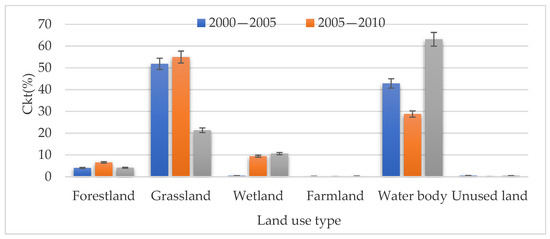
Figure 6.
Contribution rates of land-use types.
The ESVs of each ecosystem service are shown in Figure 7. The ESVs of biodiversity conservation had the biggest proportion of the total ESVs in all periods (2000–2005, 2005–2010, and 2000–2010), accounting for 34.86%, 34.64%, and 34.62%, respectively. In other words, biodiversity conservation was the most prominent function in the national nature reserves, as expected, followed by hydrology regulation (accounting for 29.49%, 29.92%, and 29.98%, respectively) and climate regulation (accounting for 13.25%, 13.13%, and 13.11%, respectively). The ESVs of nutrient circulation maintenance (0.46%) and recreation and culture (accounting for 3.10%, 3.09%, and 3.08%, respectively) had the smallest percentages. During 2000–2005, the ESVs of freshwater supply and hydrology regulation increased, by 1.15% and 1.27%, respectively, while the other ESVs all decreased by 0.89% on average. During 2005–2010 and 2000–2010, the ESVs of every ecosystem increased, by 2.18% and 1.74% on average, respectively. Although the ESV for grassland registered a substantial reduction during 2000–2005, that of water bodies registered a substantial increase over 2005–2010, resulting in an overall ESV increase. The Wilcoxon signed-rank test in SPSS 21.0 indicated that the ESVs of each ecosystem service increased significantly from 2000 to 2010 (p = 0.008 < 0.05), showing that the total ESV registered a significant increase in the national nature reserves in western China during 2000–2010.
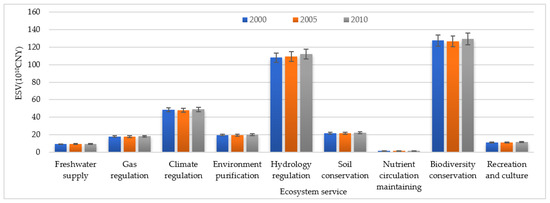
Figure 7.
Ecosystem services value of each ecosystem service function in the national nature reserves in western China.
3.3. ESV Spatial Variation
Among the 12 provinces in the western region of China, the national nature reserves in Tibet and Qinghai Province had significantly higher total ESVs, accounting for approximately 36.79% and 25.73% of the total ESV of the national nature reserves in the western region, respectively (Figure 8). In contrast, the total ESVs in the national nature reserves in Ningxia and Guizhou Province were relatively low, accounting for only 0.31% and 1.31% of the total ESV. The ESV quantities were directly related to the non-construction land area. The highest proportion of non-construction land was in the national nature reserves in Tibet and Qinghai Province, accounting for 42.83% and 23.99% of the non-construction land in the national nature reserves in the western region, while the non-construction land area in the national nature reserves in Ningxia and Guizhou Province only account for 0.51% and 0.30%, respectively. From 2000 to 2010, the ESV in the national nature reserves in Guangxi increased the most significantly, with a growth rate of 40.36%, followed by Shaanxi and Gansu, with a growth rate of 7.74% and 7.41%, respectively (Figure 9, Figure 10 and Figure 11).
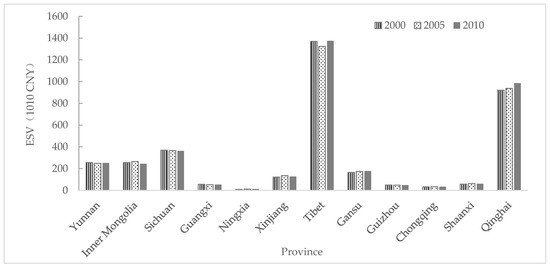
Figure 8.
Ecosystem services values of the national nature reserves in each province of western China.
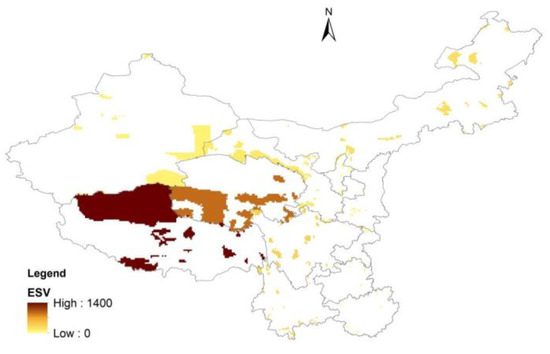
Figure 9.
Ecosystem services values in the national nature reserves of western China in 2000.
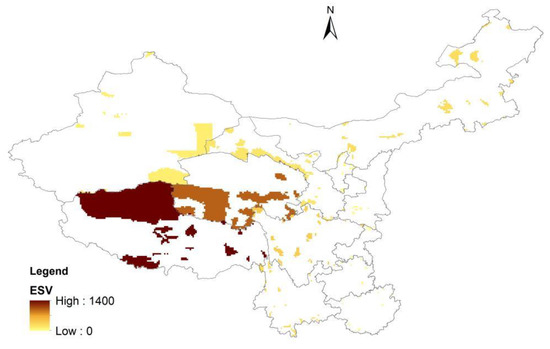
Figure 10.
Ecosystem services values in the national nature reserves of western China in 2005.
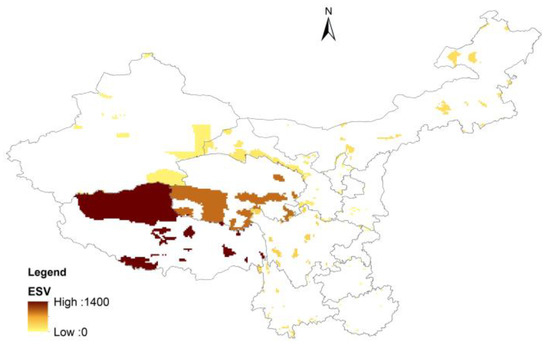
Figure 11.
Ecosystem services values in the national nature reserves of western China in 2010.
4. Discussion
At present, ecosystem services value accounting can be divided into two main categories, namely, those based on the price of a unit service function and those based on the equivalent factor of a unit area value. The function value method is used to obtain the total value based on the amount of an ecosystem service function and the unit price of the function quantity. This method simulates the ecosystem service function of a small area by establishing the production equation between a single service function and local ecological environment variables. However, the approach has many input parameters, a complicated calculation process, and more importantly, it is difficult to unify the evaluation method and parameter standards of each service value. The equivalent factor method is based on quantifiable criteria used to construct the equivalent value of various service functions of different types of ecosystems on the basis of distinguishing different kinds of ecosystem service functions, and then evaluating them in relation to the distribution area of the ecosystems [45].
Compared with the function value approach, which estimates the ESV based on ecological processes with a series of predetermined functions or models, the equivalent value factor method is more convenient and appropriate for evaluating the dynamics of ESVs over large scales [49]. Furthermore, this method was widely used and, thus, continuously improved and optimized [18,45,46,53]. Generally, nature reserves show an advantage in species resources, particularly for rare species and biomass, and thus, a correction parameter is necessary. The management of nature reserves prohibits activities such as tree felling, grazing, fishing, and gathering of herbs, and only a small number of original residents can carry out a reduced number of production activities. The overall role of food and raw material production is not important in nature reserves, and it has only a slight influence on the total ESV. As such, we did not evaluate it. Compared with the national unit ESV (39.69 × 105 CNY/km2) [49], the unit ESV in nature reserves was relatively high (42.799 × 105 CNY/km2), showing that nature reserves provide more ecosystem services owing to their higher levels of biodiversity and biomass. Based on the results of a previous survey of biodiversity in nature reserves in China and the NPP data, the equivalent factors of biodiversity conservation values and other ecosystem services were adjusted to be more in line with the actual conservation of ecosystems and biodiversity in nature reserves. The biodiversity conservation value of each unit area of different ecosystems, namely, the value of other ecological services, was obtained through the value calculation method. The value of biodiversity and the value of other ecological services were combined with changes of land types to reflect the changes in the biodiversity conservation function and other ecosystem services.
The accurate construction of the equivalent factor table is the core of the equivalent factor method. Although the adopted equivalent factor table was improved through the method of meta-analysis, the original equivalent factor table is still somewhat subjective because it relies on expert opinion scores and cannot accurately and objectively reflect the situation of ecosystem services. In addition, owing to the complexity of the ecosystems and the impact of environmental and biological conditions, there are significant differences in the size and type of their service functions. Therefore, it is objectively necessary to distinguish the ecosystem types and service categories as finely as possible. However, the lack of relevant research resulted in a lack of relevant parameters and results for some types of ecosystem services. Thus, the secondary ecosystem classification had to be adjusted and merged—for example, forest types in different zones were not distinguished—and its impact on the evaluation results needs further research and analysis [45].
Implementing the strategy of full-scale western development and accelerating the development of the western region is of great significance for expanding domestic demand and promoting the coordinated development of China’s regional economy. After the completion of the first stage, the GDP of the western region increased from CNY 1665.5 billion to CNY 6686.8 billion, giving an average annual increase of 11.9%. Development included the construction of 972,000 km of new highways, the reconstruction and expansion of 48 trunk/feeder line airports and 23 new airports, and the completion of large-scale water conservancy projects to solve the drinking water and safety problems of 94.37 million rural inhabitants, which greatly increased the economic and social development of the western region [52]. However, the fragile ecological environment in the western region should be considered in implementing the strategy of full-scale western development. Protecting and improving the ecological environment is essential for the full-scale, sustainable, and healthy development of the western region.
Western China is more economically undeveloped and ecologically fragile than central and eastern China. The environmental problems in western China are the result of the interactions between human and nature in the process of economic and social development. Even in historical times, the ecosystems in western China were destroyed by the pressure of population growth, resulting in the innate vulnerability of the ecosystems in western China. Beginning in 1953, Five-Year Plans have been China’s most important programs for economic and social development, with the early Five-Year Plans focusing on the economic dimensions [54]. Large-scale economic construction was carried out in the western region, and many industrial enterprises such as steel, coal, and oil were built, which have consumed a substantial quantity of local natural resources. The exploitation of western ecosystems, especially substantial deforestation and destruction of vegetation, have directly had catastrophic consequences. A series of ecological and environmental problems continue to emerge, such as soil erosion, drying up of water sources, abnormal climate, sandstorms, and biodiversity destruction [54].
During the ninth Five-Year Plan period, the Chinese government began to implement the strategy of developing the western region. The western development strategy is divided into three main stages of implementation: (1) the foundation stage (2000–2010), which aims to adjust the structure and improve the infrastructure, ecological environment, science and technology education; establish and perfect the market system, fostering growth industries; make preliminary improvements to the investment environment in the western region; control ecological and environmental degradation, develop a virtuous cycle of economic operation and achieve a growth rate equivalent to the national average growth level; (2) the accelerated development stage (2011–2030), which builds on the foundation stage to enter a rapid stage of western development; cultivate characteristic industries; implement a comprehensive upgrade of economic industrialization, marketization, ecology and professional regional layout; and achieve substantial economic growth; and (3) the modernization stage (2031–2050), which strengthens some of the first development areas and integrates them into the modern domestic and international economic system for self-development. This stage will focus on accelerating the development of remote mountainous areas and underdeveloped agricultural and pastoral areas, generally improving the production and living standards of the people in western China and narrowing the gap in a comprehensive way [55].
With the continuous development and improvement of the concept of ecological protection, the Chinese government’s ecological protection policy has made steady progress. The tenth Five-Year Plan (2001–2005) began to coordinate the development of the economy, society, and environment. During the eleventh Five-Year Plan (2006–2010), the government proposed “building ecological civilization”, which attracted international attention. An ecological civilization is based on respecting and preserving nature; aims at harmonious coexistence between people, between people and nature, and between people and society; and aims to establish sustainable modes of production and consumption. It guides people onto a path of sustainable and harmonious development [56]. Priority areas for the conservation of biodiversity and key ecological functions were defined during the twelfth Five-Year Plan (2011–2015), leading to an unprecedented increase in the government’s support for the conservation and improvement of the environment in the current thirteenth Five-Year Plan (2016–2020), which has further accelerated the pace of investments toward an ecological civilization [57].
In April 2022, the Chinese government included ecological civilization in the Constitution, the country’s fundamental law, demonstrating China’s determination to promote a new pattern of harmonious development between man and nature. China has implemented a wide range of national policies for ecological protection, including policies on afforestation, returning cultivated land to forest and grassland, forbidding grazing, zoning, ecological migration, which has improved land-use structure and the growth conditions of grassland vegetation, increased vegetation cover, total NPP, soil conservation, and water yield, and reduced soil erosion [34,58,59,60]. All these play important roles in nature conservation and restoring China’s degraded ecosystems, especially in western China [61,62]. Over the past decade, the ESV in the study area has shown a trend of growth. On the basis of the current analysis, the main reason for this is the increase in the ecological land areas, such as forestland and water bodies, and the significant decrease in the farmland area, which is closely related to the conversion of farmland to forest and other policies.
The water body land use includes waterways and glaciers, and the increase in waterways is the main factor for the increase in water body area. The natural conditions mean that the western region is short of water resources and this shortage has become the main factor restricting regional development. To meet the conditions of ecological civilization construction and improve people’s livelihood, the Chinese government strengthened key water source projects, water and soil conservation and ecological construction projects, and water resource allocation projects in the western region, including comprehensive watershed management projects such as the Heihe, the Tarim, and the Shiyang river basins; key soil and water conservation projects such as soil in northeast China, the Yangtze River, the middle and upper reaches of Yellow River; and water resources projects such as the first phase of the Tao Water Supply Project in Gansu Province, the Qingtongxia Irrigation area in Ningxia, the south bank trunk channel, and the irrigation area of the second phase of Qiapuqi Seawater Resources Project. These projects have greatly increased the water body area in the western region [63]. According to the ESV research in China, waterways have high ecosystem service functions, especially in hydrology regulation, freshwater supply, environmental purification, biodiversity conservation, climate regulation, and recreation and culture [45]. The expanded water body land use makes an important contribution to the ESV increase in western China.
However, the ESV in the national nature reserves in some provinces in the western region fluctuated and declined during the study period as a result of factors such as climate change and human activities. On the one hand, the increase in construction land was an important factor, such as in Sichuan, Yunnan, Guizhou. The area increase in construction land in the nature reserves was mainly due to the construction of infrastructures, such as corridors, roads, protection stations, posts, observatories, laboratories, and hydroelectric power stations. The planning of village construction and post-disaster reconstruction in nature reserves played another important role in the area increase in construction land. The older houses of the original inhabitants in the nature reserves were built of wood and were more vulnerable to the humid climate and frequent natural disasters (earthquakes, landslides, mud-rock flows, etc.). With social economic development and the growth of personal income, many rural houses were planned or rebuilt in nature reserves, resulting in an increase in the area of construction land [18]. On the other hand, the decline of ecosystem productivity caused by climate change and human activities also has a great impact on ESVs, such as in Tibet, Inner Mongolia, and Shaanxi. In the process of global warming, the plateau air and ground temperature increased significantly from 2000 to 2010, and NDVI decreased in the growing season, resulting in the decline in NPP [64,65].
With increasing global change such as climate warming and loss of biodiversity, achieving a harmonious coexistence between man and nature is a key issue that needs to be solved urgently. In the process of economic and social development, human beings should conform to the laws of nature, take measures in the light of local conditions to address important ecological and environmental problems, and transform the ecological environment from a vicious circle to a virtuous circle. Regions with an underdeveloped economy and fragile ecological environment must avoid the concept of restoration after destruction and adhere first to the practice of parallel economic development and environmental protection. Therefore, they should not exchange the ecological environment for a brief period of social and economic development, nor should they experience social and economic stagnation to promote ecological environment recovery and reconstruction. It is necessary to re-examine the rationality and appropriateness of human activities, actively adapt human activities to climate change, reduce the fragility of the ecological environment, and achieve a win–win situation of sustainable social and economic development under the premise of protecting and building the ecological environment. According to the results of the first phase of the western development strategy, the annual GDP growth rate of the western region was 11.9%, higher than the national growth rate in the same period. Breakthroughs were made in infrastructure development. A number of key projects were completed, including the Qinghai–Tibet Railway, west–east gas transmission, west–east power transmission, the western section of the main national highway, and large water conservancy projects, and the task of transmitting electricity to townships and oil roads to counties was completed. The substantial construction of transport infrastructure has changed the situation in the western region, improving logistics and allowing more convenient travel for people [66]. At the same time, the ecological environment protection measures adopted in the development and construction of the western region have greatly promoted the improvement of the ecological environment. A series of ecological projects, such as the Natural Forest Protection Project, the return of farmland to forest, and the return of grazing to grassland, have continued to expand the green area in the western region, the ecological environment was improved, and the western ecological barrier was strengthened. A total of 26.7 million ha of farmland was returned to forests, 92.7 million ha of forest resources was effectively protected by the Natural Forest Protection Project, 8.5 million ha of the Beijing–Tianjin sandstorm control project was managed, and atmospheric dust release was reduced. The number of people living in poverty fell from 55.53 million in 2001 to 26.48 million in 2008 [66]. China’s western development strategy has achieved win–win results in economic and social development and ecological and environmental protection.
5. Conclusions
The current study assessed the ESV and the changes in the nature reserves of western China in 2000–2010. During this period, the area of forestland, water bodies, and construction land increased, while the area of grassland, farmland, and unused land decreased. The total ESV increased by CNY 74.1 billion (2.02%), to which water bodies, grassland, wetland, forestland, and unused land contributed the most. Grassland and water bodies were the main factors of the total ESV dynamics. The ESV of each ecosystem service increased significantly during 2000–2010 except farmland. Consequently, the ecological conservation and restoration measures achieved good results in the national nature reserves of western China after the first stage of western development.
Through the revision of the value equivalent factor method, this paper achieved the rapid assessment of the ESV of regional nature reserves. The revised method was easy to operate and can provide a reference for the evaluation of the effect of regional ecological policy implementation. Through the evaluation, the ESV changes of national nature reserves in western China after the first stage of the implementation of China’s western development policy were analyzed, which has an important reference value for understanding changes in the national nature reserves in western China under the policy. However, limitations in the existing technology and methods resulted in a lack of relevant parameters and results for some ecosystem services. Therefore, the secondary ecosystem classification had to be adjusted and merged—for example, forest types in different zones were not distinguished—and its impact on the evaluation results needs further research and analysis.
Author Contributions
Conceptualization, Y.W. and J.G.; methodology, Y.W. and C.Z.; data analysis and processing, D.X. and N.L.; writing—original draft, Y.W.; writing—review and editing, J.G. and C.Z. All authors have read and agreed to the published version of the manuscript.
Funding
This research was funded by the National Key Research and Development Program of China (No.2020YFC1806305), Carbon Emission Peak and Carbon Neutrality Project of Jiangsu Province (No.BK20220021), and Youth Fund Project of Humanities and Social Sciences Research of the Ministry of Education(No.18YJC630216).
Institutional Review Board Statement
Not applicable.
Data Availability Statement
The data presented in this study are available in the article.
Acknowledgments
We are grateful to Lixia Wang for the assist with data processing.
Conflicts of Interest
The authors declare no conflict of interest.
References
- Zheng, H.; Ouyang, Z.; Zhao, T.; Li, Z.; Xu, W. The impact of human activities on ecosystem services. J. Nat. Res. 2003, 18, 118–126. [Google Scholar]
- Romanowicz, R.J. The impacts of changes in climate and land use on hydrological processes. Acta Geophys. 2017, 65, 785–787. [Google Scholar] [CrossRef][Green Version]
- Yu, F.; Wang, T.; Groen, T.A.; Skidmore, A.K.; Yang, X.; Ma, K.; Wu, Z. Climate and land use changes will degrade the distribution of Rhododendrons in China. Sci. Total Environ. 2019, 659, 515–528. [Google Scholar] [CrossRef] [PubMed]
- Hopping, K.A.; Knapp, A.K.; Dorji, T.; Klein, J.A. Warming and land use change concurrently erode ecosystem services in Tibet. Glob. Chang. Biol. 2018, 24, 5534–5548. [Google Scholar] [CrossRef] [PubMed]
- IPCC (International Panel on Climate Change). The IPCC Fifth Assessment Report 2014. 2014. Available online: http://www.ipcc.ch/report/ar5/ (accessed on 2 July 2021).
- Xinhua. How Long Will the Four-Continent Fever Last? Global Weather Extremes are Expected to Increase in the Future. 2021. Available online: http://news.china.com.cn/2018-08/05/content_58101737.htm (accessed on 2 July 2021).
- MEA (Millennium Ecosystem Assessment). Ecosystems and Human Well-Being: Synthesis. 2005. Available online: http://www.millenniumassessment.org/documents/document.356.aspx.pdf (accessed on 2 July 2021).
- Trumbore, S.; Brando, P.; Hartmann, H. Forest health and global change. Science 2015, 349, 814–818. [Google Scholar] [CrossRef]
- Scholes, R.J. Climate change and ecosystem services. WIREs Clim. Chang. 2016, 7, 537–550. [Google Scholar] [CrossRef]
- Sample, J.E.; Baber, I.; Badger, R. A spatially distributed risk screening tool to assess climate and land use change impacts on water-related ecosystem services. Environ. Model. Softw. 2016, 83, 12–26. [Google Scholar] [CrossRef]
- Bhattarai, U. Impacts of climate change on biodiversity and ecosystem services: Direction for future research. Hydro Nepal J. Water Energy Environ. 2017, 20, 41–48. [Google Scholar] [CrossRef]
- Huggard, C.J.; Gómez, A.R. Struggle in an endangered empire: The search for total ecosystem management in the forests of Southern Utah, 1976–1999. In Forests under Fire: A Century of Ecosystem Mismanagement in the Southwest; University of Arizona Press: Tucson, AZ, USA, 2002; pp. 211–240. [Google Scholar]
- Li, S.; Zhai, H. The Comparison Study on Forestry Ecological Projects in the World. Acta Ecol. Sinic. 2002, 22, 1976–1982. [Google Scholar]
- Li, S. The ecological projects in the world. World Environ. 1993, 4, 31–33. [Google Scholar]
- Li, S. Comparison on conversion of cropland to forest and grassland in the world. World For. Res. 2002, 15, 22–27. [Google Scholar]
- Hao, T.; Xu, J.; Zhang, L. Chinese environmental economy policy and the preferential policy of reforestation and revegetation. Chin. Agric. Sci. Bull. 2005, 21, 349–363. [Google Scholar]
- Yan, W.; Li, H.; Meng, W. European and American ecological network planning enlightenment to China’s. Environ. Protect. 2010, 18, 64–66. [Google Scholar]
- Wang, Y.; Gao, J.; Wang, J.; Wu, Y.; Zou, C.; Tian, M.; Zheng, H. Evaluating losses in ecosystem services in nature reserves in Sichuan, China. Int. J. Sustain. Dev. World Ecol. 2014, 21, 290–301. [Google Scholar] [CrossRef]
- Mu, S.; Zhou, K.; Fang, Y.; Zhu, C. The need and the prospects for developing large-scale green corridors to protect biodiversity. Biodiv. Sci. 2014, 22, 242–249. [Google Scholar]
- Liu, G.; Yang, Z.; Chen, B.; Zhang, L.; Zhang, Y.; Su, M. An ecological network perspective in improving reserve design and connectivity: A case study of Wuyishan nature reserve in China. Ecol. Model. 2015, 306, 185–194. [Google Scholar] [CrossRef]
- Xinhua. Statistics Represent a Historic Leap—The Statistics Showing China’s Achievements in Economic and Social Development over the Past 40 Years of Reform and Opening-Up. 2018. Available online: http://www.xinhuanet.com/politics/2018-08/27/c_1123337404.htm (accessed on 2 July 2021).
- Li, X.; Zhang, J.; Xu, L. An evaluation of ecological losses from hydropower development in Tibet. Ecol. Eng. 2015, 76, 178–185. [Google Scholar] [CrossRef]
- Amesheva, I. Environmental degradation and economic development in China: An interrelated governance challenge. Law Dev. Rev. 2017, 10, 425–450. [Google Scholar] [CrossRef]
- Ouyang, Z.; Zheng, H.; Xiao, Y.; Polasky, S.; Liu, J.; Xu, W.; Wang, Q.; Zhang, L.; Xiao, Y.; Rao, E.; et al. Improvements in ecosystem services from investments in natural capital. Science 2016, 352, 1455–1459. [Google Scholar] [CrossRef]
- Zhang, L.; Fan, J.; Zhou, D.; Zhang, H. Ecological protection and restoration program reduced grazing pressure in the three-river headwaters region, China. Rangel. Ecol. Manag. 2017, 70, 540–548. [Google Scholar] [CrossRef]
- Huang, L.; Shao, Q.; Liu, J.; Lu, Q. Improving ecological conservation and restoration through payment for ecosystem services in Northeastern Tibetan Plateau, China. Ecosyst. Serv. 2018, 31, 181–193. [Google Scholar] [CrossRef]
- Liao, C.; Yue, Y.; Wang, K.; Fensholt, R.; Tong, X.; Brandt, M. Ecological restoration enhances ecosystem health in the karst regions of southwest China. Ecol. Indic. 2018, 90, 416–425. [Google Scholar] [CrossRef]
- Sheng, W.; Zhen, L.; Xiao, Y.; Hu, Y. Ecological and socioeconomic effects of ecological restoration in China’s Three Rivers Source Region. Sci. Total Environ. 2019, 650, 2307–2313. [Google Scholar] [CrossRef]
- Wang, X.; Shen, Y.; Cong, R.; Lu, Q. Conflicts affecting sustainable development in West China since the start of China’s Western development policy. J. Res. Ecol. 2012, 3, 202–208. [Google Scholar]
- SC (The State Council of the People’s Republic of China). Notice of the State Council on the Implementation of Policies and Measures for the Large-Scale Development of the Western Region. 2000. Available online: http://www.gov.cn/gongbao/content/2001/content_60854.htm6 (accessed on 2 July 2021).
- Lu, F.; Hu, H.; Sun, W.; Zhu, J.; Liu, G.; Zhou, W.; Zhang, Q.; Shi, P.; Liu, X.; Wu, X.; et al. Effects of national ecological restoration projects on carbon sequestration in China from 2001 to 2010. Proc. Natl. Acad. Sci. USA 2018, 115, 4039–4044. [Google Scholar] [CrossRef] [PubMed]
- WDDNDRC (West Development Department of National Development and Reform Commission). Achievement of western development in 10 years is brilliant. New West 2009, 24, 4–5. [Google Scholar]
- Peng, X.; Chen, Z. Impact evaluation on China’s western development policy. China Pop. Res. Environ. 2016, 26, 136–144. [Google Scholar]
- Yang, B.; Wang, Q.; Xu, X. Evaluation of soil loss change after Grain for Green Project in the Loss Plateau: A case study of Yulin, China. Environ. Earth Sci. 2018, 77, 304. [Google Scholar] [CrossRef]
- SC (The State Council of the People’s Republic of China). Remarkable Achievements Have Been Made in Ecological Protection in the Western Region. 2006. Available online: http://www.gov.cn/ztzl/2006-01/01/content_145209.htm (accessed on 2 July 2021).
- Renmin. Achievements in the Western Development Region in the Past 10 Years. 2009. Available online: http://finance.people.com.cn/GB/8215/174398/10547501.html (accessed on 2 July 2021).
- Yang, X.; Xu, B.; Jin, Y.; Qin, Z.; Ma, H.; Li, J.; Zhao, F.; Chen, S.; Zhu, X. Remote sensing monitoring of grassland vegetation growth in the Beijing–Tianjin sandstorm source project area from 2000 to 2010. Ecol. Indic. 2014, 51, 244–251. [Google Scholar] [CrossRef]
- Wang, J.; Peng, J.; Zhao, M.; Liu, Y.; Chen, Y. Significant trade-off for the impact of grain-for-green programme on ecosystem services in North-western Yunnan, China. Sci. Total Environ. 2017, 574, 57–64. [Google Scholar] [CrossRef]
- MEE (Satellite Application Center for Ecology and Environment). Available online: http://www.secmep.cn/secPortal/portal/index.faces (accessed on 2 August 2020).
- LAADS DAAC (Level-1 and Atmosphere Archive & Distribution System Distributed Active Archive Center). Available online: http://ladsweb.nascom.nasa.gov/data/search.html (accessed on 4 August 2020).
- National Meteorological Science Data Center. Available online: http://data.cma.cn/ (accessed on 4 August 2020).
- China Centre For Resources Satellite Data and Application. Available online: http://westdc.westgis.ac.cn (accessed on 9 August 2020).
- NBS (National Bureau of Statistics). China Statistical Yearbook; China Statistics Press: Beijing, China, 2011. [Google Scholar]
- PBNDRC (Price Bureau of National Development and Reform Commission). Compilation of Data on Cost and Income of Agricultural Products Nationwide; China Statistics Press: Beijing, China, 2011. [Google Scholar]
- Costanza, R.; Folke, C. Valuing ecosystem services with efficiency, fairness, and sustainability as goals. In Nature’s Services: Societal Dependence on Natural Ecosystems; Daily, G.C., Ed.; Island Press: Washington, DC, USA, 1997; pp. 49–68. [Google Scholar]
- Xie, G.; Zhang, C.; Zhang, M.; Chen, W.; Li, S. Improvement of the evaluation method for ecosystem service value based on per unit area. J. Nat. Res. 2015, 30, 1243–1254. [Google Scholar]
- Wu, K.-Y.; Ye, X.-Y.; Qi, Z.-F.; Zhang, H. Impacts of land use/land cover change and socioeconomic development on regional ecosystem services: The case of fast-growing Hangzhou metropolitan area, China. Cities 2013, 31, 276–284. [Google Scholar] [CrossRef]
- Costanza, R.; de Groot, R.; Sutton, P.; van der Ploeg, S.; Anderson, S.J.; Kubiszewski, I.; Farber, S.; Turner, R.K. Changes in the global value of ecosystem services. Glob. Environ. Chang. 2014, 26, 152–158. [Google Scholar] [CrossRef]
- Xie, G.; Zhang, C.; Zhen, L.; Zhang, L. Dynamic changes in the value of China’s ecosystem services. Ecosyst. Serv. 2017, 26, 146–154. [Google Scholar] [CrossRef]
- Potter, C.S.; Randerson, J.T.; Field, C.B.; Matson, P.A.; Vitousek, P.M.; Mooney, H.A.; Klooster, S.A. Terrestrial ecosystem production: A process model based on global satellite and surface data. Glob. Biogeochem. Cycles 1993, 7, 811–841. [Google Scholar] [CrossRef]
- Monteith, J.L.; Moss, C.J. Climate and the efficiency of crop production in Britain. Philos. Trans. R. Soc. B 1977, 281, 277–294. [Google Scholar] [CrossRef]
- SCIO (The State Council Information Office of the People’s Republic of China). Remarkable Achievements in the Ten Years of the China Western Development. 2010. Available online: http://www.scio.gov.cn/ztk/xwfb/10/4/Document/695231/695231.htm (accessed on 2 July 2021).
- Xie, G.; Zhen, L.; Lu, C.; Xiao, Y.; Chen, C. Expert knowledge based valuation method of ecosystem services in China. J. Nat. Res. 2008, 23, 911–919. [Google Scholar]
- Qin, D.; Ding, Y.; Wang, S.; Wang, S.; Dong, G.; Lin, E.; Liu, C.; She, Z.; Sun, H.; Wang, S.; et al. A study of environment change and its impacts in western China. Earth Sci. Front. 2002, 9, 321–328. [Google Scholar]
- HPRC(The History of the People’s Republic of China). Large-Scale Development of China’s Western Region. 2009. Available online: http://www.hprc.org.cn/gsgl/dsnb/zdsj/200908/t20090820_28292_2.html (accessed on 9 September 2022).
- Xie, P. Natural arche of ecological civilization. J. Lake Sci. 2016, 28, 1–8. [Google Scholar]
- Gao, J.; Wang, Y.; Zou, C.; Xu, D.; Lin, N.; Wang, L.; Zhang, K. China’s ecological conservation redline: A solution for future nature conservation. Ambio J. Hum. Environ. 2020, 49, 1519–1529. [Google Scholar] [CrossRef]
- Zhang, J.; Wang, T.; Ge, J. Assessing vegetation cover dynamics induced by policy-driven ecological restoration and implication to soil erosion in Southern China. PLoS ONE 2015, 10, e0131352. [Google Scholar] [CrossRef] [PubMed]
- Dang, D.; Li, X.; Li, S.; Dou, H. Ecosystem services and their relationships in the grain-for-green programme—A case study of Duolun county in inner Mongolia, China. Sustainability 2018, 10, 4036. [Google Scholar] [CrossRef]
- Ren, Y.; Kuuluvainen, J.; Toppinen, A.; Yao, S.; Berghäll, S.; Karppinen, H.; Xue, C.; Yang, L. The effect of China’s new circular collective forest tenure reform on household non-timber forest product production in natural forest protection project regions. Sustainability 2018, 10, 1091. [Google Scholar] [CrossRef]
- Cao, S. Why large-scale afforestation efforts in china have failed to solve the desertification problem. Environ. Sci. Technol. 2008, 42, 1826–1831. [Google Scholar] [CrossRef]
- Wang, Y.; Gan, Y.; Fei, D.; Tai, F. Study on restoration effects of enclosed pasture in pastureland rehabilitation areas in northwestern Sichuan province. Pratacult. Sci. 2008, 25, 15–19. [Google Scholar]
- China Daily. Major Water Conservancy Projects Carried out during the Decade of the Great Western Development. 2009. Available online: http://www.chinadaily.com.cn/dfpd/xibu10nian/2009-12/21/content_11176695.htm (accessed on 9 September 2022).
- Wang, H.; Zhang, L.; Shi, X.; Li, D. Some new changes of the regional climate on the Tibetan Plateau since 2000. Adv. Earth Sci. 2021, 36, 785–796. [Google Scholar]
- Zhang, X.; Lu, X.; Wang, X. The spatial and temporal variation of NDVI and its relationships to climatic factors in Northern Tibet over the period of 2000–2010. Mt. Res. 2014, 32, 475–480. [Google Scholar]
- Xinhua. A Good Start and a Solid Foundation—A Review of the Achievements of the Great Western Development in the Past Decade. 2010. Available online: http://www.gov.cn/jrzg/2010-07/05/content_1646123.htm (accessed on 9 September 2022).
Publisher’s Note: MDPI stays neutral with regard to jurisdictional claims in published maps and institutional affiliations. |
© 2022 by the authors. Licensee MDPI, Basel, Switzerland. This article is an open access article distributed under the terms and conditions of the Creative Commons Attribution (CC BY) license (https://creativecommons.org/licenses/by/4.0/).